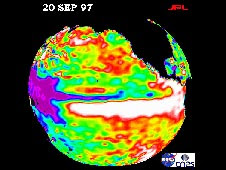 Water sphere "behavior" experiments aboard the International Space Station. Image Credit: NASA
Water sphere "behavior" experiments aboard the International Space Station. Image Credit: NASAWatch the video on YouTube
Water rationing and recycling are an essential part of daily life and operations on the space shuttles and International Space Station. In orbit, where Earth's natural life support system is missing, the International Space Station has to provide abundant power, clean water, and breathable air at the right temperature and humidity for the duration of human habitation and with virtually no waste. The Environmental Control and Life Support System (ECLSS), under continuing development at the Marshall Space Flight Center, helps astronauts use and reuse their precious supplies of water. Future work will explore air management, thermal control, and fire suppression -- in short, all of the things that will make human habitation in space comfortable and safe.
 The ECLSS Water Recycling System (WRS) reclaims wastewaters from humans and lab animals in the form of breath condensate, urine, hygiene and washing, and other wastewater streams. On Earth, biological wastewater is physically filtered by granular soil and purified as microbes in the soil break down urea, converting it to a form that plants can absorb and use to build new tissue. Wastewater also evaporates and returns as fresh rain water -- a natural form of distillation. WRS water purification machines on the ISS mimic these processes, though without microbes or the scale of these processes.
The ECLSS Water Recycling System (WRS) reclaims wastewaters from humans and lab animals in the form of breath condensate, urine, hygiene and washing, and other wastewater streams. On Earth, biological wastewater is physically filtered by granular soil and purified as microbes in the soil break down urea, converting it to a form that plants can absorb and use to build new tissue. Wastewater also evaporates and returns as fresh rain water -- a natural form of distillation. WRS water purification machines on the ISS mimic these processes, though without microbes or the scale of these processes.A NASA industry partner, Umpqua Research Company, of Myrtle Creek, Oregon, supplier of the bacterial filters used in the life support backpacks worn by space-walking astronauts, helped develop air and water purification technologies for human missions in space. To prevent back-contamination of a drinking water supply by microorganisms, Umpqua developed the microbial check valve, consisting of a flow-through cartridge containing iodinated ion exchange resin. In addition to the microbial contact kill, the resin was found to impart a biocidal residual elemental iodine concentration to the water.
Umpqua's valve and resin system was adopted by NASA as the preferred means of disinfecting drinking water aboard U.S. spacecraft, and canisters are now used on space shuttle missions, the ISS, and for ground-based testing of closed life support technology. Iodine was selected by NASA as the disinfectant of choice because of its lower vapor pressure and reduced propensity for formation of disinfection byproducts compared to chlorine or bromine.
MRLB International Inc., of Fergus Falls, Minnesota, used Umpqua's water purification technology in the design of the DentaPure waterline purification cartridge (Spinoff 1998). It was designed to clean and decontaminate water as a link between filter and high-speed dental tools and other instruments, and offers easy installation on all modern dental unit waterlines with weekly replacement cycles. The product, like its NASA forebear, furnished disinfected water and maintained water purity even with "suckback," an effect caused by imperfect anti-retraction valves in dental instruments, which draws blood, saliva, and other materials from a patient's mouth into the waterline.
Various models of DentaPure now address a variety of needs, and are used in dental offices and schools across the country. The technology offers remarkable filtration: registered to provide 200 CFU/ml purity (Colony Forming Unit/milliliter, a standard measure of microbial concentration) -- the Centers for Disease Control and Prevention (CDC) standard is 500 CFU, and untreated lines can harbor in excess of 1,000,000 CFU/ml.
Better filtration, greater capacity, and longer service intervals have also led to great savings -- the University of Maryland Dental School estimates it saves $274,000 per year courtesy of DentaPure. The DentaPure system has proven so effective that 40 percent of dental schools nationwide employ it.
The investment in water filtration for space missions continues to pay huge dividends to users and society, year after year, in technologies so woven into our lives that we use them without even thinking about them.
DentaPure® is a registered trademark of MRLB International Inc.
> Read the entire story in Spinoff 2008


























